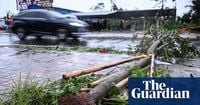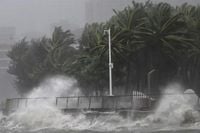Typhoon Matmo, the 21st named storm of the 2025 Pacific typhoon season, barreled into the southern coast of China on October 5, 2025, unleashing ferocious winds, torrential rains, and a wave of emergency measures that spanned multiple provinces. As the storm intensified and neared landfall, authorities in Guangdong, Hainan, and Guangxi scrambled to safeguard millions of residents and tourists, triggering one of the largest mass evacuations in recent years.
According to Xinhua, the island province of Hainan had already relocated over 197,000 people from high-risk areas by noon on October 5, operating under a typhoon red alert—the highest level in China’s warning system. In neighboring Guangdong Province, the response was just as urgent. Emergency officials there raised their typhoon emergency response to the highest level, evacuating more than 150,000 people from coastal and low-lying areas by Sunday, with that number swelling to over 200,000 as the storm’s trajectory became clearer.
Guangxi Zhuang Autonomous Region also braced for impact. All coastal passenger ferry routes were suspended, and approximately 26,000 tourists on Weizhou Island were safely evacuated, with no one left stranded, as reported by Xinhua and Reuters. Coastal projects and ports ground to a halt, and 4,024 personnel from ships and offshore oil platforms were relocated to safety. The maritime authority in Guangxi activated a top-level emergency response early Sunday, guiding 168 vessels to secure waters and anchoring 889 ships in port, a move that likely prevented maritime disasters as the typhoon’s winds whipped up high seas.
By mid-afternoon on October 5, Typhoon Matmo made landfall along the eastern coast of Xuwen County, Zhanjiang City in Guangdong Province. According to China’s National Meteorological Center, maximum wind speeds near the center reached 42 meters per second (about 94 mph), with a central minimum pressure of 965 hectopascals. Shortly after, the China Meteorological Administration warned of “extreme weather conditions” and urged residents to remain vigilant, as Matmo’s winds peaked at 45 meters per second (with some reports noting gusts up to 48 meters per second as the storm accelerated toward Guangdong).
Local media and AP footage showed dramatic scenes: large waves crashing onto coastal roads in Zhanjiang, seawater flooding villages, and staff piling heavy items against doors to hold them shut against the relentless wind. In Maoming City, less than 100 kilometers from the storm’s landfall, debris from wind-ripped roofs littered seaports, a stark reminder of the typhoon’s raw power.
In Hainan, the impact was no less severe. All flights and ferry services were canceled from the evening of October 4, and schools, businesses, and public transport were suspended to reduce risk. According to Reuters, all 49 ferries—both passenger and cargo—were moved to safe zones. Emergency teams were put on standby, and local authorities stockpiled supplies to address potential disruptions in power and communication. The National Emergency Management Agency deployed an additional 1,500 personnel to assist with rescue and relief operations, anticipating the need for swift response as the storm raged on.
Schools and businesses across the region remained shuttered, and transportation networks, including high-speed rail, were suspended until further notice. The closure of public institutions and the suspension of transport affected not only local residents but also thousands of tourists, especially as the storm coincided with a busy holiday travel period.
Preliminary assessments, as reported by The Paper and Reuters, indicated that nearly 300,000 people had been evacuated in Guangdong and Hainan combined. The total number of evacuees across all affected provinces reached approximately 347,000, according to state media. Authorities emphasized the importance of minimizing casualties and property damage, and, so far, there were no reports of fatalities or major injuries—a testament to the scale and speed of the response.
But the storm’s impact was not limited to evacuations and infrastructure. Meteorological authorities forecasted that Matmo, after making landfall, would move west-northwest, weakening as it entered the Beibu Gulf by evening. Still, the threat of flash flooding and landslides loomed large, with expected rainfall between 3.93 to 9.8 inches (100 to 250 millimeters) in parts of Guangdong and Hainan. In the region of Macau, classes and tutoring sessions were canceled due to the adverse weather, even though the city was not in the typhoon’s direct path.
As Matmo moved inland, authorities shifted their focus to restoring life after the storm. Emergency crews were deployed to restore power and communication networks, and efforts began to gradually resume air and maritime connectivity as weather conditions allowed. The gradual reopening of schools and businesses was planned with an emphasis on safety, as roads and infrastructure were checked for damage.
Matmo’s rampage through southern China followed a path that had already affected the northern Philippines earlier in the week. According to AP, the storm impacted more than 220,000 people there, with nearly 35,000 seeking shelter away from landslide- or flood-prone areas. Fortunately, there were no reports of significant casualties or major damage, though the storm’s reach was felt across the region.
Looking ahead, meteorologists expected Matmo to continue its westward and northern journey, heading toward northern Vietnam and China’s Yunnan province. Authorities in those areas remained on alert, with disaster-response agencies monitoring the situation closely.
China’s southern provinces have faced their share of powerful typhoons in recent years, but the response to Matmo demonstrated both improved coordination and a determination to protect lives and property. As one emergency official told Xinhua, “Our priority is always the safety of the people. We acted quickly and decisively, and we’ll keep working until everyone is safe and recovery is complete.”
As the region begins to pick up the pieces, the lessons of Typhoon Matmo—about preparedness, rapid response, and community resilience—will no doubt shape how China confronts future storms.





